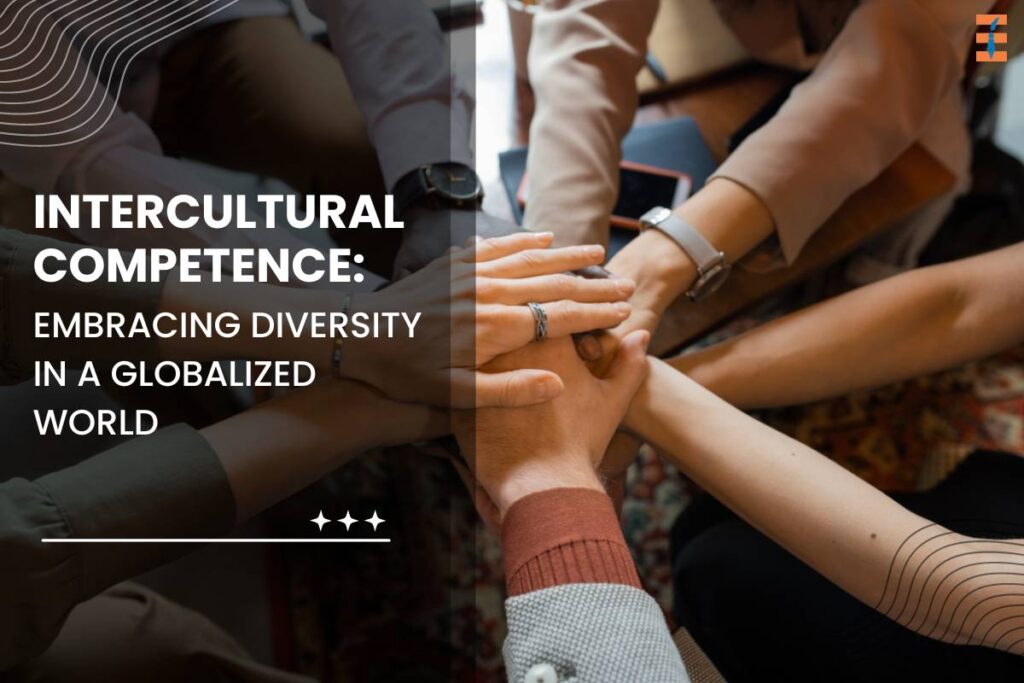The world feels smaller these days, right? We’re all connected thanks to technology and travel, but that also means bumping into people from completely different backgrounds. That’s where something called “intercultural competence” comes in. It’s a fancy way of saying you have the skills and knowledge to navigate different cultures. Imagine being able to talk to someone from another country and actually understand each other, even if you don’t speak the same language! Intercultural competence helps us bridge those gaps, fostering respect and cooperation between people from all over the world. It’s a valuable skill for business, school, travel, or even just chatting with your neighbor who recently moved from across the ocean.
Understanding Intercultural Competence
At its core, intercultural competence refers to the capability to appropriately and effectively communicate, relate, and work with individuals from diverse cultural backgrounds. It goes beyond simple tolerance of differences and involves actively seeking to understand, appreciate, and learn from diverse perspectives. It encompasses various dimensions, including cultural awareness, empathy, communication skills, flexibility, and adaptability.
1. Cultural Awareness

Developing intercultural competence begins with recognizing and understanding one’s own cultural beliefs, values, norms, and biases. This self-awareness forms the foundation for appreciating and respecting cultural differences in others.
2. Empathy
Empathy plays a crucial role in intercultural competence by allowing individuals to understand and share the feelings, perspectives, and experiences of people from different cultural backgrounds. Empathetic communication fosters trust, openness, and collaboration across cultures.
3. Communication Skills
Effective communication across cultures requires not only linguistic proficiency but also an understanding of cultural nuances, nonverbal cues, and communication styles. Clear, respectful, and context-appropriate communication bridges cultural gaps and promotes meaningful interactions.
4. Flexibility and Adaptability
Cultivating flexibility and adaptability enables individuals to navigate unfamiliar cultural contexts, adjust their behavior and communication style accordingly, and embrace new ways of thinking and doing things.
Importance of Intercultural Competence
In today’s globalized and interconnected world, this is more than a desirable skill—it is a necessity. Here are several key areas where intercultural competence plays a pivotal role:
1. Global Business and Economy
In multinational corporations, international trade, and global markets, it is essential to build successful business relationships, negotiate agreements, and understand diverse consumer preferences and behaviors.
2. Education and Research
Intercultural competence is vital in educational settings, where students and educators from different cultural backgrounds collaborate, exchange ideas, and learn from each other. It promotes inclusive learning environments and enhances cross-cultural research collaborations.
3. Diplomacy and International Relations
Diplomats, policymakers, and global leaders rely on intercultural competence to navigate complex geopolitical landscapes, foster diplomatic relations, and resolve international conflicts through dialogue and mutual understanding.
4. Social Integration and Community Development
In diverse societies, it promotes social cohesion, inclusion, and respect for cultural diversity. It helps bridge divides, reduce stereotypes, and build harmonious communities.
5. Travel and Tourism

For travelers and tourists exploring different countries and cultures, it enhances their experiences by facilitating meaningful interactions with local communities, respecting cultural norms, and avoiding cultural misunderstandings.
Strategies for Developing Intercultural Competence
Developing intercultural competence is an ongoing process that requires self-reflection, learning, practice, and a willingness to engage with diverse perspectives. Here are strategies individuals and organizations can adopt to enhance their intercultural competence:
1. Cultural Self-Awareness
Start by reflecting on your own cultural identity, beliefs, values, biases, and communication style. Recognize how your cultural background influences your perceptions and interactions with others.
2. Cultural Learning and Education
Actively seek opportunities to learn about different cultures, histories, languages, customs, and traditions. Engage in cultural sensitivity training, language courses, intercultural workshops, and cross-cultural experiences.
3. Empathetic Listening and Perspective-Taking
Practice active listening and empathy by genuinely seeking to understand others’ perspectives, experiences, and emotions. Avoid making assumptions or judgments based on stereotypes.
4. Cross-Cultural Communication Skills
Enhance your verbal and nonverbal communication skills in diverse cultural contexts. Be mindful of cultural differences in communication styles, body language, gestures, and personal space.
5. Cultural Immersion and Experiential Learning
Immerse yourself in diverse cultural environments through travel, cultural exchanges, international internships, or volunteer opportunities. Engage with local communities, build relationships, and learn firsthand about different ways of life.
6. Cultural Sensitivity and Respect
Demonstrate respect for cultural diversity by honoring customs, traditions, values, and etiquette norms in different cultural settings. Be open-minded, curious, and respectful in your interactions with people from diverse backgrounds.
7. Continuous Reflection and Feedback
Reflect on your intercultural experiences, challenges, successes, and areas for growth. Seek feedback from peers, mentors, or cultural experts to gain insights and improve your intercultural competence.
Challenges and Opportunities in Developing Intercultural Competence
While developing intercultural competence brings numerous benefits, it also poses challenges and complexities that individuals and organizations must navigate:
1. Cultural Bias and Stereotypes
Overcoming ingrained cultural biases, stereotypes, prejudices, and misconceptions requires conscious effort, self-awareness, and open-mindedness.
2. Communication Barriers
Language barriers, misinterpretations, and cultural differences in communication styles can lead to misunderstandings, conflicts, or ineffective collaboration. Building communication skills and cultural sensitivity is crucial.
3. Cultural Adaptation and Adjustment
Adapting to new cultural environments, norms, values, and social norms can be challenging, especially during cross-cultural transitions such as international relocations or multicultural team collaborations.
4. Conflict Resolution
Cultural differences may sometimes lead to conflicts or misunderstandings. Developing skills in conflict resolution, negotiation, and cultural diplomacy is essential for resolving disputes and maintaining positive relationships.
5. Globalization and Cultural Homogenization
As global interactions increase, there is a risk of cultural homogenization or the loss of unique cultural identities. Promoting cultural diversity, preservation, and mutual respect is vital in a globalized world.
Despite these challenges, embracing intercultural competence opens doors to diverse perspectives, innovation, creativity, and enriched personal and professional experiences. It fosters inclusive environments where individuals from different backgrounds feel valued, heard, and empowered to contribute their unique insights and talents.
The Role of Technology in Fostering Intercultural Competence
Technology plays a pivotal role in facilitating intercultural interactions, learning, and collaboration across geographical boundaries. Here are ways technology contributes to developing intercultural competence:
1. Virtual Communication Platforms
Video conferencing, instant messaging, and virtual collaboration platforms enable real-time communication and collaboration among individuals from diverse cultural backgrounds, overcoming geographical barriers.
2. Online Learning and Cultural Resources

E-learning platforms, cultural exchange programs, and online resources provide access to multicultural education, language learning, intercultural training, and virtual cultural experiences.
3. Social Media and Global Networking
Social media platforms and online communities connect people worldwide, fostering cross-cultural friendships, dialogue, and cultural exchange. It allows individuals to share perspectives, experiences, and cultural insights.
4. Cross-Cultural Projects and Collaborations
Technology facilitates global teamwork, joint projects, and virtual collaborations among multicultural teams, promoting intercultural understanding, cooperation, and innovation.
5. Cultural Sensitivity Training and Simulations
Virtual reality (VR) and augmented reality (AR) technologies enable immersive cultural simulations, empathy-building experiences, and interactive cultural sensitivity training for professionals and students.
Promoting Intercultural Competence in Organizations and Education
Organizations, educational institutions, and governments play a crucial role in promoting this among individuals and communities. Here are strategies for fostering intercultural competence in different settings:
1. Diversity and Inclusion Initiatives
Implement diversity and inclusion policies, training programs, and initiatives that celebrate cultural diversity, prevent discrimination, and promote equitable opportunities for all.
2. Cross-Cultural Training and Workshops
Provide intercultural training, workshops, and seminars for employees, students, educators, and professionals to enhance their cultural awareness, communication skills, and cross-cultural competence.
3. Cultural Exchange Programs
Facilitate international exchange programs, study abroad opportunities, and cross-cultural projects that expose individuals to diverse cultural experiences, perspectives, and challenges.
4. Interdisciplinary and Intercultural Collaboration
Encourage interdisciplinary and intercultural collaborations in research, education, and innovation, fostering diverse teams that bring together varied expertise and cultural insights.
5. Cultural Competence Assessment and Feedback
Develop tools, assessments, and feedback mechanisms to evaluate and improve individuals’ and organizations’ intercultural competence, providing resources and support for continuous learning and growth.
6. Community Engagement and Partnerships
Engage with local communities, cultural organizations, and global partners to promote cultural exchange, mutual understanding, and collaborative initiatives that address global challenges.
Conclusion
In a world characterized by globalization, diversity, and interconnectedness, nurturing intercultural competence is not just a professional advantage but a fundamental necessity for fostering inclusive, respectful, and harmonious societies. By embracing cultural diversity, cultivating empathy, honing communication skills, and fostering cross-cultural collaboration, individuals and organizations can navigate global challenges, promote mutual understanding, and build a more interconnected and culturally rich world.
Developing intercultural competence is a lifelong journey that requires curiosity, humility, openness, and a commitment to continuous learning and growth. As we navigate complex global issues and opportunities, it serves as a bridge that connects us across cultures, fosters meaningful connections, and celebrates the richness of human diversity. Let us embrace this journey with curiosity, empathy, and a shared vision of building a more inclusive and interconnected global community.

